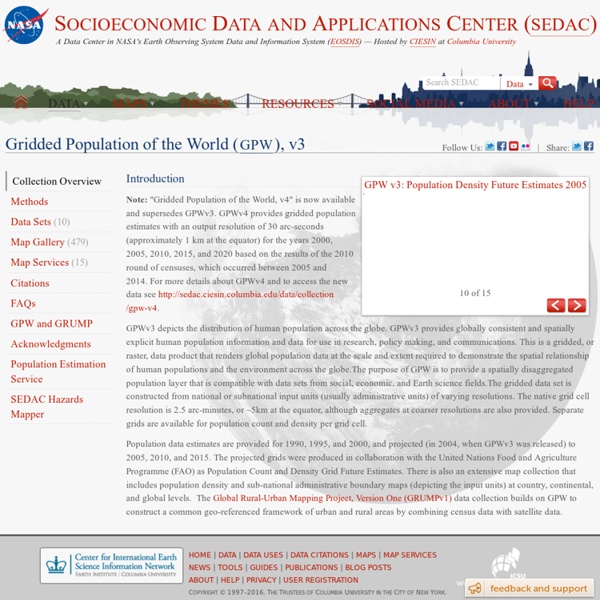



Map Collection Digital Maps The Harvard Map Collection is one of the oldest and largest collections of cartographic materials in the United States with over 500,000 items. Resources range from 16th century globes to modern maps and geographic information systems (GIS) layers. A selection of our materials has been digitally imaged and is offered both as true picture images and georeferenced copies. This Virtual Collection includes those maps and atlases that are available through the Harvard Image Delivery Service. Those maps that have been georeferenced are available through the Harvard Geospatial Library. Only a small portion of the Map Collection has been cataloged and included in the HOLLIS catalog and an even smaller selection are included in this virtual collection as digital images.
Mapping global urban and rural population distributions The previous chapter reviewed definitions of urban and rural areas, and analysed what statistical data are available and what georeferenced datasets could be used as potential inputs into models of population distribution. In this chapter, the two most widely known and used georeferenced global population distribution databases that have been developed based on these sources are reviewed and several recent efforts to model population distribution, taking urban and rural areas explicitly into account are described. The Gridded Population of the World (GPW), originally developed at the National Center for Geographic Information Analysis (NCGIA) and subsequently updated by the Center for International Earth Science Network (CIESIN) at Columbia University, attributes population to the lowest subnational administrative units for which population counts are available. The GPW project was the first major attempt to generate a consistent global georeferenced population dataset.
World Sunlight Map Watch the sun rise and set all over the world on this real-time, computer-generated illustration of the earth's patterns of sunlight and darkness. The clouds are updated daily with current weather satellite imagery. The Mercator projection used here is one way of looking at the spherical earth as a flat map. Used since the 16th century for navigation, straight lines on this map can be used accurately as compass bearings but the size and shape of continents are distorted. Compare this with Peters, Mollweide or equirectangular projection maps. Also available is a semi-realistic view of dawn and dusk from far above the Earth, a look at the moon, and information about how this works.
List of countries by population growth rate The population growth rate estimates (by United Nations) for the period 2005–2010 using the medium variant. This article includes three lists of countries and self-governing dependent territories by population growth rate. Methodology[edit] The first list is based on the estimates taken from the 2006 edition of the United Nations World Population Prospects report.[1] Figures are population growth rate estimates for the period 2005–2010 using the medium variant. The second list is based on CIA World Factbook estimates for year 2011.[2] Dependent territories and not fully recognized states are not ranked. The third list is based on World Bank estimates for year 2009.[3] Population is based on the de facto definition of population, which counts all residents regardless of legal status or citizenship—except for refugees not permanently settled in the country of asylum, who are generally considered part of the population of the country of origin. Countries[edit] See also[edit] World population
Google Maps Transparencies Imagery ©2014 TerraMetrics Terms of Use Report a map error Map Satellite Map Data Map data ©2014 Google Google Maps Transparencies Click and drag anywhere, just like normal Google Maps, and see how the Map View matches the Satellite View (or vice-versa). - or - - or - Enter your own Latitude/Longitude in the format shown below. Built using the new Google Maps API Bugs, problems, suggestions? Link to this page Introduction to Political Philosophy About the Course This course is intended as an introduction to political philosophy as seen through an examination of some of the major texts and thinkers of the Western political tradition. Three broad themes that are central to understanding political life are focused upon: the polis experience (Plato, Aristotle), the sovereign state (Machiavelli, Hobbes), constitutional government (Locke), and democracy (Rousseau, Tocqueville). View class sessions » Course Structure This Yale College course, taught on campus twice per week for 50 minutes, was videotaped for Open Yale Courses in Fall 2006. The Open Yale Courses Series For more information about Professor Smith’s book Political Philosophy, click here. Course Materials Download all course pages [zip - 10MB] Video and audio elements from this course are also available on: About Professor Steven B. Steven B. Syllabus Professor Steven B. Description Texts Requirements There will be three short papers (5-7 pages each) and a final exam. Grading Sessions
World Subways at Scale Athens Attiko Metro Ecosistema Urbano Ecosistema Urbano combine expertise in architecture, civil engineering and landscape architecture, focusing on designing sustainable urban environments. Based in Madrid, they have developed projects for the regeneration of urban areas through a focus on social activity and increasing biodiversity. Their EcoBoulevard project in a Madrid suburb was designed to mitigate the effects of rampant urban development with little concern for environmental and social conditions. Consisting of a number of 'air trees', these self-sustaining structures powered by solar energy create public space whilst also tempering the hot climate through climbing plants and atomisers that cool and moisten the air. Any excess energy is sold back to the grid and helps fund the maintenance of the structures. References About Javier Arpa, 'Ecosistema Urbano. Fundación COAM, Tato Vallejo Garica Setien Ecosistemaurbano (Madrid: EA! Connections
Home Page